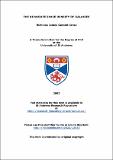Files in this item
The bivariate space density of galaxies
Item metadata
| dc.contributor.advisor | Driver, Simon | |
| dc.contributor.author | Cross, Nicholas James Geraint | |
| dc.coverage.spatial | xxxvi, 187 p. | en_US |
| dc.date.accessioned | 2018-03-14T09:46:05Z | |
| dc.date.available | 2018-03-14T09:46:05Z | |
| dc.date.issued | 2002 | |
| dc.identifier.uri | https://hdl.handle.net/10023/12935 | |
| dc.description.abstract | The luminosity function of galaxies, the measurement of the space density as a function of luminosity, is an important test of cosmology, galaxy formation and evolution. Unfortunately, there is a factor of two variation in recent measurements of the luminosity function. Most of this variation is due to systematic errors, caused by various selection effects. With two large new surveys, the Two degree Field Galaxy Redshift Survey and the Sloan Digital Sky Survey, underway it is important to recognise and eliminate these selection effects if we are going to improve our measurement of the luminosity function and fully utilise these surveys. By measuring the space density of galaxies as a function of surface brightness as well as luminosity, a bivariate brightness distribution, we can comprehend many of the selection effects such as light loss, incompleteness and the visibility of galaxies. Since galaxies have a variety of shapes and sizes, a distribution in luminosity and surface brightness helps to separate out different types of galaxy. Correlations between the luminosity and surface brightness place extra constraints on models of galaxy formation and evolution. When we analyse our results, we find that recent surveys that have not taken into account surface brightness selection effects underestimate the luminosity of the bright end by 5-10%. Using the bivariate brightness distribution, we can constrain the luminosity density to a range that varies by < 20% rather than by a factor of 2. We find that the luminosity function is flat over the range -19.5 < M < -17 and then rises sharply as late-type spiral galaxies begin to dominate. The space density does not vary with surface brightness with the result that low surface brightness galaxies are at least as common as normal galaxies. However, low surface brightness galaxies are also intrinsically faint, following the luminosity-surface brightness correlation for spirals, so they do not contribute significantly to the luminosity density. | en_US |
| dc.language.iso | en | en_US |
| dc.publisher | University of St Andrews | |
| dc.subject.lcc | QB857.5D3C8 | |
| dc.subject.lcsh | Galaxies--Formation. | en |
| dc.subject.lcsh | Galaxies--Evolution. | en |
| dc.title | The bivariate space density of galaxies | en_US |
| dc.type | Thesis | en_US |
| dc.type.qualificationlevel | Doctoral | en_US |
| dc.type.qualificationname | PhD Doctor of Philosophy | en_US |
| dc.publisher.institution | The University of St Andrews | en_US |
This item appears in the following Collection(s)
Items in the St Andrews Research Repository are protected by copyright, with all rights reserved, unless otherwise indicated.

